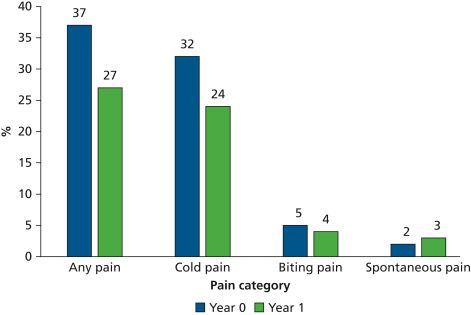Abstract
Background
This article reviews the most salient lessons learned from a large, multisite, 3-year
observational study of posterior teeth with cracks conducted by The National Dental
Practice–Based Research Network.
Types of Studies Reviewed
Eight articles published over a 6-year period (2017-2022) describing clinical characteristics
of posterior teeth with cracks and their treatment and outcomes are reviewed and discussed
to answer 3 common questions faced by oral health care clinicians: Which cracked teeth
will get worse? When should practitioners intervene? What is the best treatment?
Results
Although cracks in teeth are prevalent, few will fracture (3%) or show crack progression
in 3 years (12%). Characteristics that guide the clinician to treatment include active
caries, biting pain, and to a lesser degree, having a crack detectable with an explorer,
connecting with a restoration, or blocking transilluminated light; the main treatment
chosen is a complete crown. Of those teeth treated (36%), few (14%) will need retreatment
but will still survive, despite having an internal crack as well.
Conclusions and Practical Implications
Although cracked teeth often pose a dilemma to clinicians, clincians are generally
good at deciding which teeth to treat and when and which to monitor.
Article Info
Publication History
Published online: January 21, 2023
Publication stage
In Press Corrected Proof
Footnotes
The National Dental Practice-Based Research Network Collaborative Group comprises practitioner, faculty, and staff investigators who contributed to this network activity. A list of these people is available at http://www.nationaldentalpbrn.org/collaborative-group.php.
Disclosures. Drs. Hilton and Funkhouser did not report any disclosures. Dr. Ferracane is the editor-in-chief of JADA Foundational Science, an American Dental Association journal.
This work was supported by grants U19-DE-28717 and U19-DE-22516 from the National Institutes of Health.
Opinions and assertions contained in this article are those of the authors and are not to be construed as necessarily representing the views of the respective academic institutions or the National Institutes of Health.
The authors are grateful to The National Dental Practice-Based Network’s regional node coordinators and other network staff (Midwest region: Tracy Shea, RDH, BSDH; Western region: Stephanie Hodge, MA; Northeast region: Christine O’Brien, RDH; South Atlantic region: Hanna Knopf, BA, and Deborah McEdward, RDH, BS, CCRP; South Central region: Shermetria Massengale, MPH, CHES, and Ellen Sowell, BA; Southwest region: Stephanie Reyes, BA, Meredith Buchberg, MPH, and Colleen Dolan, MPH; network program manager, Andrea Mathews, BS, RDH; and program coordinator, Terri Jones), along with network practitioners and their dedicated staff who conducted these studies.
Identification
DOI: https://doi.org/10.1016/j.adaj.2022.11.020
Copyright
© 2023 American Dental Association. All rights reserved.
ScienceDirect
Access this article on ScienceDirect


